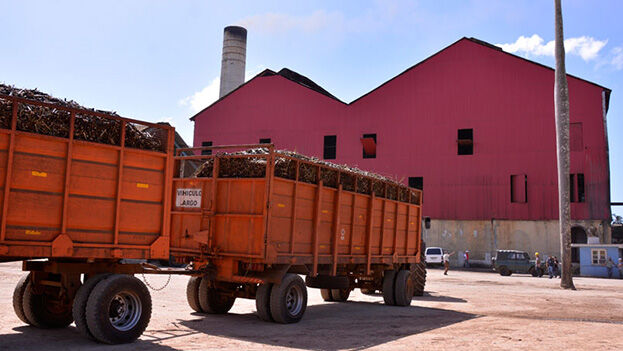
![]() 14ymedio, Havana, 21 March 2022 — The preliminary results of the 2022-2023 sugar harvest continue to deepen the failure of the planned resuscitation of the sunken sugar sector, which was once the engine of growth for the Cuban economy. The latest press reports in Santiago de Cuba, Las Tunas and Ciego de Ávila indicate that none of the three provinces has met the production plan.
14ymedio, Havana, 21 March 2022 — The preliminary results of the 2022-2023 sugar harvest continue to deepen the failure of the planned resuscitation of the sunken sugar sector, which was once the engine of growth for the Cuban economy. The latest press reports in Santiago de Cuba, Las Tunas and Ciego de Ávila indicate that none of the three provinces has met the production plan.
Irayaselis Bandera, an official of the Agroindustrial Company Azucarera Dos Ríos, located in the Santiago municipality of Palma Soriano, acknowledged to the provincial newspaper Sierra Maestra that the situation is “complex,” as 10,577 tons of raw sugar have been produced, 53.7% of the 19,321 that it must achieve for this year.
Bandera explained that the production of sugar has been interrupted by a deficit of cane seed. The lack of fuel and parts for the means of transport, as well as breakdowns in the mill equipment, add to the list of problems.
Despite the meager results, Osvaldo Arias Quezada, the mill administrator, argued that “efforts are aimed at supplying enough for the basic basket” of Cuban families. The official pointed out that 500 workers “manage solutions” for breakdowns of machines, some of which have had more than half a century of operation.
The only achievement highlighted by Arias Quezada is energy self-sufficiency and its contribution to the National Energy System in two Soviet turbogenerators with an installed capacity of four megawatts (MW) each.
In the province of Las Tunas, the Majibacoa mill also got off on the wrong foot, and preliminary results indicate that it will not be able to meet the production goal. David Puig Brito, general director of the sugar company, told Periódico 26 that as of March 18, the mill had generated 13,000 tons of raw sugar, 55.9% of the 23,227 tons that must be delivered by April 19.
Puig Brito believes that if the mill has enough cane “we will fulfill the plan even before the scheduled date,” but this means that they must produce a similar amount of sugar as that generated in the last three months, since the milling work began in January.
Majibacoa along with Antonio Guiteras are the only mills of the four active in the province assigned to the milling of sugar for this cycle, while the Colombia and Amancio Rodríguez sugar mills were relegated only to obtaining cane syrup and clarified juice.
Puig Brito acknowledged that recently they had to stop the machines, for up to a week, due to a broken mat in February. Despite “the problems,” the director added, the plant is considered to be the most efficient in Cuba with an industrial yield of 12.75 metric tons of sugar per 100 tons of ground cane. “We are taking advantage of the cane like no other in the country,” he said with a triumphant tone.
But the improvement in performance is not enough to alleviate the problems of the mill, which is working with 32 of the 47 machines. It also does not have tires or batteries for vehicles, in addition to the fact that seven of the vehicles do not work due to technical problems. However, the note of the official newspaper minimizes the crisis by assuring that the mill collective “feels optimistic” and “enthusiastic” because it knows “the vital importance of producing sugar today.”
Also far from the goal of the production plan, with a compliance of 50.9%, is the Azcuba Sugar Group, in Ciego de Ávila. Eduardo Larrosa Vázquez, director of the company, acknowledged on March 17 that there are “tensions” among the workers because they have only managed to produce 28,000 tons of the 55,000 required.
“There is no room for expansion,” added Larrosa Vázquez, who said that in the next 60 days “all available resources plus incentives for workers” will be used to reach the pledged amount of sugar.
The director defended the delays at the Ciro Redondo mill, saying they are due to the breakdowns of the boilers of a bioelectric plant due to the shortages of power of the Electrical System at the beginning of February. Only this mill, he continued, has “a debt” of almost 17,000 tons for the current harvest and, to date, it has produced more than 14,000 tons.
Cuba began the 2022-2023 sugar harvest last November with the goal of producing 455,198 tons of sugar, below the 473,720 tons obtained in the previous cycle. Most of it will be used for the family basket, tourism and the production of medicines and industrial products. It is not yet known if the country will be able to respect the agreements signed with its usual international buyers.
The results of the other 23 sugar mills for this cycle have yet to be known, but Azcuba acknowledged last February that the deficit was 95,000 tons of sugar.
Translated by Regina Anavy
____________
COLLABORATE WITH OUR WORK: The 14ymedio team is committed to practicing serious journalism that reflects Cuba’s reality in all its depth. Thank you for joining us on this long journey. We invite you to continue supporting us by becoming a member of 14ymedio now. Together we can continue transforming journalism in Cuba.
